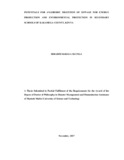| dc.description.abstract | Sewage biogas is one of the renewable green energy that is being developed in many
countries of the world using anaerobic digestion. However, its utilisation in Kenya may be
facing various challenges such as socio-economic, cultural and religious believes. It is
strongly believed that secondary schools can generate energy from sewage to supplement
biomass energy while protecting the environment. Sewage poses health risks due to poor
disposal methods. It is against this background that this study assessed potentials for
anaerobic digestion of sewage for energy production and environmental protection in
secondary schools of Kakamega County, Kenya. The study was guided by four objectives:
determine the quantity of sewage generated in secondary schools for potential energy
generation in Kakamega County, Kenya; examine the potential environmental impact of
chemical and microbial characteristics of the sewage generated; determine the economic and
environmental benefits of anaerobic digestion of sewage for energy generation and evaluate
the enhancement strategies in secondary schools for anaerobic digestion of sewage for
energy generation and environmental protection. The study adopted four research designs:
cross-section survey, experimental, correlational and evaluative to achieve its objectives.
Focused Group Discussions, Key informants, interviews, questionnairesand observation
check lists were used to collect data. Data were analyzed both descriptively and inferentially
by using Graph Pad Prism 5, Excel and SAS and subjecting them to Chi-square and t-test,
cross tabulation and evaluation. It was established that secondary schools in Kakamega
County generate 17,662.3 tons of human waste per school academic year of 273 days with
an energy equivalent of 43,273.6gj. The chemical characteristics in the sewage generated
are: Total Kjeldal Nitrogen (TKN) 8.30 mg/l with a Standard Error (SE) of 0.45; pH 5.75
with SE of 0.13; Total Phosphate (P2O5)1.15mg/l with SE of 0.46; Cd 0.0249 mg/l; Pb
0.0046 mg/l; Dry Matter(DM) 13.80% with SE of 0.66. The microbial characteristics in the
sewage generated are: E.coli 390 MPN/100mls and faecal coliforms 450 MPN/100 mls. The
anaerobically digested effluent increased its concentration of TKN and P2O5 by 8.2% and
1.7% respectively. Its pH also increased by 26.1%. However, the DM, E.coli and faecal
coliforms reduced by 61.8%, 74.4% and 88.89% respectively. The traceable quantities of
heavy metals remained unchanged in the effluent after the Anaerobic Digestion (AD)
process. The infrastructure, concerted efforts of all stakeholders and socio-economic factors
are of paramount importance in realizing the anaerobic digestion of sewage in secondary
schools for bioenergy production. Key players in this respect were the school sponsors.
Majority of these sponsors accepted the use of sewage for energy generation in their
schools. The students who are the direct beneficiaries of sewage energy generation are also
in support of the idea. The study established that there is a substantial quantity of sewage
generated in secondary schools of Kakamega County for sewage energy generation. If
everything is held constant 21% ofwood fuel would be replaced by sewage energy. The
microbial characteristics of the sewage generated in secondary schools impact negatively on
the environment by causing pollution of the soils and water. Economically, AD of sewage
will supplement the wood fuel used by schools for their cooking and heating needs.
Environmentally, the process reduces the E.coli and faecal coliforms concentrations in the
effluent to harmless trace levels. The decrease in DM means that less space will be required
hence reduced rate of refilling. A decrease in E. coli and faecal coliforms meant that some
important biological process was going on in the environment. The increase in P2O5 and
TKN is beneficial to soils as bio nutrients. Generally, the use of sewage bioenergy will help
reduce the effect of methane on the biosphere. There is adequate support from the
stakeholders for the use of sewage in secondary schools to generate energy. | en_US |

